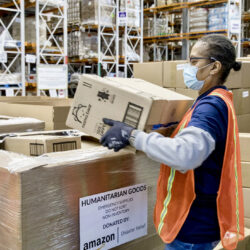Amazon opens first Disaster Relief Hub in Europe

Amazon is opening its first European Disaster Relief Hub (DRH) in Germany. The hub will be equipped with a thousand pallets of relief goods by the e-commerce giant. Amazon’s global logistics network can also be used during natural disasters to send essential products to non-profit organizations and partners. The hub is located at its fulfilment centre in Rheinberg, an area with easy access to major international airports and transport networks.
Bettina Stix, Head of Amazon Disaster Relief, says: “Natural disasters are becoming more frequent and increasingly severe. With our global inventory, logistics infrastructure and technology, we support communities affected by these emergencies. We worked with local and international relief organizations to understand their needs, and have researched which products are most needed in the aftermath of natural disasters.”
The new 2,000m2 German hub is equipped to provide assistance for the most common natural disasters in Europe, including floods and forest fires. Items stored include shelter supplies, hygiene kits and cleaning supplies. After analysing products requested in natural disasters since 2017, Amazon found that more than 80% of the items needed are the same each time. The most requested products are nappies, quilts, blankets, heaters, tents and cleaning supplies.
Using its own data and information obtained from relief organizations, Amazon teams have millions of relief items ready to be packed – when needed – and sent to affected communities. Amazon can deliver aid in less than 72 hours thanks to the hub – faster than if the products were scattered across different facilities.
Cooperation with aid organizations
Throughout the year, Amazon works with national and international relief organizations, including the Red Cross, Save the Children and the International Organization for Migration (IOM), to understand their needs and be ready to deliver the products they need in advance. These collaborations have enabled Amazon to respond to more than 145 natural disasters around the world since 2017, and to donate more than 24 million relief items.
Besides donating products and providing logistics services, Amazon has also made it easy for customers to donate products through the company’s online shops. When the Russian invasion of Ukraine began, customers from across Europe used Amazon to send products to aid partners for distribution to displaced Ukrainian families. In addition, Amazon has also been able to assist with natural disasters worldwide in the past 18 months, including forest fires in Chile, Colombia, Australia and Hawaii, earthquakes in Japan, Turkey, Syria and Morocco, and hurricanes and cyclones in Puerto Rico, Florida and India.
Cloud computing for better assistance
Besides using its extensive logistics to get goods to affected areas quickly, Amazon Web Services (AWS) is also helping organizations harness the power of cloud computing to improve disaster relief. For example, AWS is working with the American Red Cross to develop cloud computing solutions, such as devices equipped with Alexa to receive hurricane warnings and to schedule blood donations.
AWS also has a dedicated Disaster Response team that helps partners prepare for and respond to disasters globally using cloud technology. Examples include testing proof-of-concepts and refining existing innovations under simulated disaster conditions. For instance, AWS Disaster Response vehicles could be used to deploy connectivity networks after internet and telecom infrastructure is severely damaged. These vehicles are equipped with powerful and portable cloud computing devices, designed for deployment in the harshest conditions.
Fighting forest fires with cloud technology
AWS has used cloud technology to help partners map and assess damage in severely affected areas, restore internet connectivity and scale up call centres to handle more post-disaster requests. The team also provides computing power to relief organizations in the field to process information on the ground. This allows them to make faster decisions about where to focus their aid.
Recently, AWS also provided cloud technology and expertise to support teams fighting forest fires in Chile, Colombia and Maui. Using cutting-edge technology, the teams gained insight into the extent of damage caused by the fires and were able to identify and monitor new fires. The teams also used aerial surveillance imagery to generate maps for decision-making and preventive measures.










